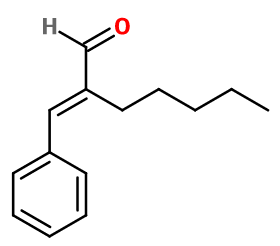Jasmonal A®
Synthétique
Floral > Light Flowers > White Flowers > Berries > Anisic

Crédits photo: ScenTree SAS
Other names :
Amyl Cinnamaldehyde ; Amyl Cinnamaldehyde ; 2-benzylideneheptanal ; Amyl cinnamal ; Amylcinnamaldehyde ; Amylcinnamal ; 2-benzylidene heptanal ; Buxine ; Flomine ; Flosal ; Floxine ; 2-(phenylmethylene)-heptanal ; Jasmin aldehyde ; Jasminal ; Jasminaldehyde ; Jasmona ; Jasmine aldehyde ; 2-pentyl cinnamaldehyde
Volatility :
Heart/Base
Uses in perfumery :
Jasmonal A® is useful for light floral accords such as spring and white flowers : jasmine, lilac, tuberose or narcissus notes. Also used in fruity notes.
Natural availability :
Jasmonal A® is found in trace amounts in some black teas. However, it is synthetic Jasmonal A® that is most often used in perfumery.
Year of discovery :
1926
Other comments :
Jasmonal A® is more powerful, rising and soapy, but less watery than Jasmonal H®.
Jasmonal A® is one of the 26 allergens in perfumery.
Jasmonal A® is one of the 26 allergens in perfumery.
Price Range :
€€
Stability :
Aldehydes may form diethylacetals in alcoholic perfumes, with no real impact on their smell.
Jamsonal A colors through time.
Jamsonal A colors through time.

Crédits photo: ScenTree SAS
- Molecular formula :
- C14H18O
- Molecular Weight :
- 202,3 g/mol
- Density :
- 0,967
- Flash Point :
- 94°C
- Fusion Point :
- <0°C
- Appearance :
- Colorless liquid
- Log P :
- 4,7
- Boiling Point :
- 289°C
- Detection Threshold :
- Donnée indisponible.
Synthesis route :
As for Cinnamaldehyde, the synthesis of Jasmonal A® is made by a condensation of Benzaldehyde with heptanal (Aldehyde C-7), using an excess of Benzaldehyde and gradually adding the Aldehyde C-7 in order to avoid it self-condensation.
Synthesis precursor :
Jasmonal A® is not a precursor to the synthesis of another compound of olfactory interest.
Isomerism :
Jasmonal A® has a double bond that gives rise to two possible diastereoisomers of the molecule. However, it is the mixture of the two diastereoisomers that is used in perfumery.
- EINECS number :
- 204-541-5
- FEMA number :
- 2061
- JECFA number :
- 685
- FLAVIS number :
- 05.040
- Allergens :
- Jasmonal A® may provoke an allergic reaction on skin contact (redness, heat, scraching, prickling) for some people.
- IFRA :
- This ingredient is restricted by IFRA
- Restriction type :
- RESTRICTION
- Cause of restriction :
- DERMAL SENSITIZATION AND SYSTEMIC TOXICITY
- Amendment :
- 49
- Comments :
- This ingredient is part of the Schiff base (α-Amylcinnamaldehyde-methyl anthranilate (or Jasmea, Seringone) - N°CAS : 68527-78-6) and induces the application of IFRA regulations for 60,3% of the Schiff base usage. Please also refer to the IFRA Annex II for more information
- Quantitative limit on the use :
-
Cat.1 Cat.2 Cat.3 Cat.4 Cat.5A Cat.5B Cat.5C Cat.5D Cat.6 0,58 % 0,53 % 0,26 % 7 % 2,5 % 0,32 % 0,45 % 0,11 % 0,064 % Cat.7A Cat.7B Cat.8 Cat.9 Cat.10A Cat.10B Cat.11A Cat.11B Cat.12 0,26 % 0,26 % 0,11 % 1,5 % 1,5 % 3,5 % 0,11 % 0,11 % No Restriction - Restriction type :
- RESTRICTION QRA
- Cause of restriction :
- SENSITIZATION
- Amendment :
- 47
- Comments :
- This ingredient is part of the Schiff base (α-Amylcinnamaldehyde-methyl anthranilate (or Jasmea, Seringone) - N°CAS : 68527-78-6) and induces the application of IFRA regulations for 60,3% of the Schiff base usage. Please also refer to the IFRA Annex II for more information
- Quantitative usage limits :
-
Cat.1 Cat.2 Cat.3 Cat.4 Cat.5 Cat.6 Cat.7 Cat.8 Cat.9 Cat.10 Cat.11 0,7 % 0,9 % 3,6 % 10,7 % 5,6 % 17,1 % 1,8 % 2 % 5 % 2,5 % Not Restricted
To learn more about IFRA's standards : https://ifrafragrance.org/safe-use/library
ScenTree is solely responsible for the information provided here.
Do you sell any of the raw materials? Would you like to let our users know?
Send an email to fournisseurs@scentree.co to learn about our advertising opportunities.
